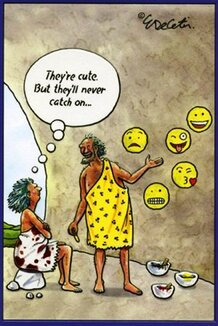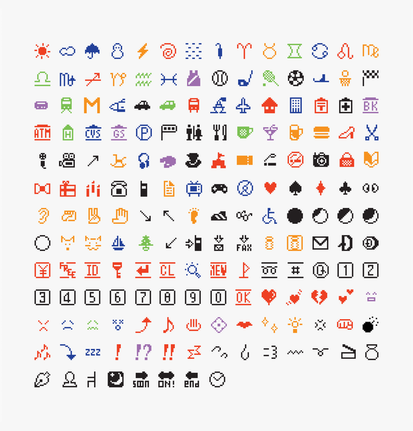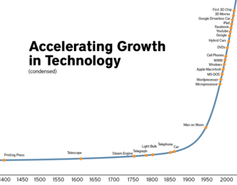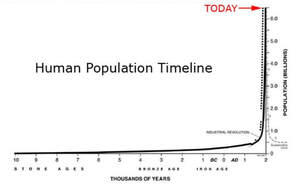
The modern human species [Homo sapiens] evolved about 200,000 years ago in Africa. The ability to think and plan for the future, to remember and learn from the past, is what distinguishes humans as being a “higher order of consciousness.”
Researchers believe that language came into being only 100,000 years ago. [And you were worried when your child didn’t speak until age 3.]
Language, in this context, means a systematic way that members of a social group [in this case, homo sapiens] communicate with and express themselves to each other using verbal, manual, and written symbols.
The modern human species developed about 200,000 years ago. Researchers believe that language came into being only 100,000 years ago. [And you were worried when your child didn’t speak until age 3.]
Language, in this context, means a systematic way that members of a social group [in this case, homo sapiens] communicate with and express themselves to each other using verbal, manual, and written symbols.

Because the oldest of ancient cave art has been dated at 64,000 years – the projected age is up for grabs depending on what you read -- it makes sense that linguists conclude verbal language developed before the written/artistic expression. That is an ongoing debate. Archeologists are always making new discoveries, and dating methodologies are becoming more versatile, sophisticated, and accurate every year.
The point is that humans presumably walked first, spoke second, and didn’t get around to written symbols until later in their evolutionary history.
Lions, Chauvet Cave, France (Courtesy Jean Clottes, Chauvet Cave Project)
Photo Source: archaeology.org/issues/221-1607/

Over the past 50,000 years or so, human society has come a long way.
Progress came very slowly at the earliest stages of development and population growth but began to accelerate about 1400 to become faster and faster along with technological advancements.
The following graphs give a visual idea of the rate of population growth and technological advancement for the last 10,000 years and technological growth since 1400 AD. The indicators are fuzzy [my apologies] but the important visual aspect is the curve: the rate of growth.
Original source: Unknown Photo Credit Scrapes project
Image source:whizolosophy.com/growth in technology Photo source: scientificamerican.com/population-growth
Close to the top of the technology curve is the late 20th century when we began to use computers.
Computers initially produced text, which is only one dimension of communication. Evidently, text alone was not adequate to communicate completely.
In 1982, Scott Fahlman, professor at Carnegie Mellon, developed the emoticon because he felt user posts, specifically humor, on an internal online bulletin board were misinterpreted. Text alone didn’t effectively convey the context you get from other forms of communication: vocal tonality, hand gestures, body language, or facial expressions. [Note that emoticons are not the same as emoji.]
The need for conveying emotion did exist, and soon a proliferation of emoticons exploded on the internet, none of them consistent with the other. For example, the font Wingdings was developed and used by Microsoft. When I tried to give an example here, this platform won't accept that front. However, wingdings was not readable by me...and probably not readable by most people who were just beginning to buy and use cell phones. Emoticons, despite the name, were also unable to communicate emotion.
Kaomojio - Image source:
medium.com/@heytory/emojis
This was followed in the 90’s by a variety of digital smiley faces and pictograms, a different set on each platform, making them untransferable to another operating system, so to speak.
In 1987 the Unicode Consortium, a non-profit organization, was created to develop a universal character encoding scheme called Unicode. Before Unicode, there were hundreds of competing standards for text encoding, similar to the same problem pictorial symbols were facing.
RISE OF THE EMOJI
Eventually, the emoji* was born. Emoji in the strict sense refers to such pictures which can be represented as encoded characters. Any number of our modern languages use pictorial symbols for letters and words, so the concept isn’t new, but the need for this kind of written symbols originated with computer and cell phone communications.

They were so successful that other mobile carriers designed their own, which were then proprietary and couldn’t be used by other companies.
The first and Original Set of Kurita’s Empoji Shigetaka Kurita
Image Source: cnn.com/emoji-shigetaka-kurita Photo source: webdesignerdepot.com/history-of-emojis/

In 2007, a team at Google requested that the Unicode Consortium recognize and create universal standards around emoji to unify the pictograms cross-platform.
The original proposal was accepted, and 114 emoji were added to Unicode 5.2. By 2017 there were 2,666 emoji on the official Unicode Standard list.
The fact that emoji do not represent words but rather emotions lets people add emphasis through gesticulation. Essentially, by adding a gesture to a word adds a personal emotion which helps clarify the text.
IS EMOJI THE FIRST UNIVERSAL LANGUAGE?
English is often referred to as the universal language, but if you look at the numbers, that belief doesn’t hold up.
“English has 339 million native speakers, with a further 603 million speakers who use it as a second language. This means there are around 942 million more-or-less fluent speakers in the world. And with another 500-plus million users with some degree of fluency, that makes for more than 1.5 billion people alive today with proficiency in English. But here comes the undiplomatic put-down; in comparison, Emoji dwarfs even the reach of English.”
Vyv Evans [Professor of Linguistics | Language & Digital Communication Consultant | Author | Public Speaker | Broadcaster] 08-05-2017 |linkedin.com/pulse/emoji-new-universal-language
Evans statistical support of that last statement is rather overwhelming.
Fahlman, when he developed the emoticon, suggested that it might become the universal language, but it didn’t. While many agree that emoji, the offspring of emoticon, enriches communication, there are those who are withholding their opinions about it being the universal language. Just as there can be confusion between words in any language [such as flat versus apartment ] emoji can be easily misinterpreted and mean different things to different cultures, language and age groups.
The HighSpeedInternet.com conducted a study which found the following as some of the most confusing emoji internationally. Image source: https://www.highspeedinternet.com/resources/emojis-the-universal-language-of-the-internet
And because of that countries, cultural groups, communities, even social groups have attributed certain emoji with meanings that were not originally intended. Quite a few studies have been conducted which corroborate this. In China, for example, the simple smiley face may be interpreted as a sign of sarcasm. The V for victory emoji is offensive to those in the UK; Chinese consider the hand-wave to be a snub, and the thumbs-up and horn sign have sexually explicit undertones in certain countries. Eggplants and peaches have a similar problem. Emoji are even used by gang members to set up drug deals and commit crimes.
ARE EMOJI EVEN A LANGUAGE?
My own opinion, based on my research, is that emoji have become an integral part of the internet-electronic communication language which supplements the text portion by adding emotion and/or humor. It is also a playful relief to text, which can be painfully sterile.

Without the text, more complex thoughts and communications can be misinterpreted just as easily as words. After all, text was not the primary way the vast majority of humans communicated until the printing press was invented in the 1400s. On the evolutionary time line, that’s right next door to electronic communications, emoji, and exploration of Mars.
In an obtuse way, homo sapiens have come full circle in that we still need verbal, manual, written symbols to communicate with each other. The only difference is that we’re communicating on a different, much higher platform.
Just sayin’.
□
*Note: The word emoji can be singular or plural, but apparently discussions between linguists are moving toward plural.
Sources:
https://en.wikipedia.org/wiki/Emoji
https://medium.com/@heytory/emojis-the-complete-history-6dc81a330144
https://www.todaytranslations.com/about/language-history/emoji-language-history/https:/www.todaytranslations.com/about/language-history/emoji-language-history/
https://zapier.com/blog/use-emoji/
https://www.webdesignerdepot.com/2016/10/the-surprising-history-of-emojis/
https://www.news18.com/news/buzz/universal-language-or-culturally-specific-symbols-what-do-emojis-really-mean-1796371.html#:~:text=Many%20have%20said%20that%20emojis,can't%20read%20or%20write.
https://www.highspeedinternet.com/resources/emojis-the-universal-language-of-the-internet
https://www.bbc.com/future/article/20151012-will-emoji-become-a-new-language
https://www.languageinsight.com/blog/2019/is-emoji-becoming-a-global-language/#:~:text=The%20word%20Emoji%20comes%20from,modern%2Dday%2C%20global%20language.
https://www.linkedin.com/pulse/emoji-new-universal-language-its-making-us-better-vyv-evans#:~:text=Emoji%20is%2C%20today%2C%20incontrovertibly%20the,highly%20instructive%20point%20of%20departure.
https://medium.com/@Wolfestone/the-full-circle-from-caveman-paintings-language-to-emojis-f0f92ee5c2
https://blog.frontiersin.org/2018/03/07/language-cave-art-mit/
https://www.nationalgeographic.com/news/2018/02/acoustic-caves-rock-art-language-origin-spd/#:~:text=Representing%20Thought,date%20back%20roughly%2040%2C000%20years.
https://en.wikipedia.org/wiki/Cave_of_Maltravieso
http://www.scientificamerican.com/article/human-population-growth-creeps-back-up/https:/charnaflamscrapesproject.weebly.com/%22
https://whizolosophy.com/category/today-s-world-projecting-tomorrow/gallery-charts-graphs/accelerating-growth-in-technology
https://www.webdesignerdepot.com/2016/10/the-surprising-history-of-emojis/
https://www.cnn.com/style/article/emoji-shigetaka-kurita-standards-manual/index.html
https://www.archaeology.org/issues/221-1607/trenches/4551-trenches-france-chauvet-dating





 RSS Feed
RSS Feed